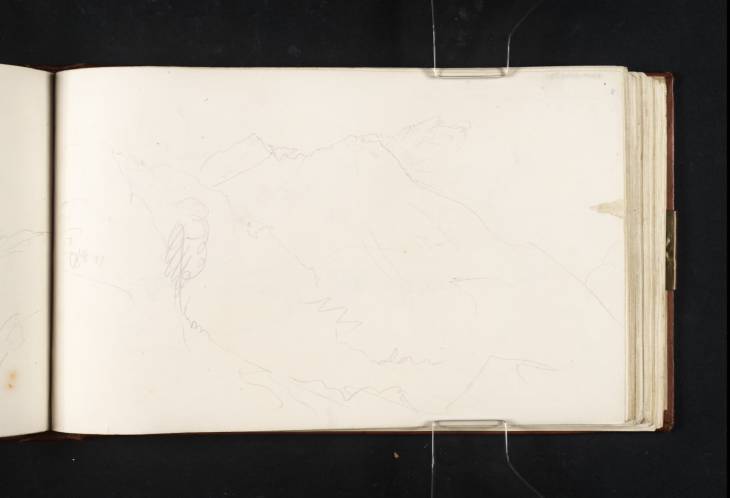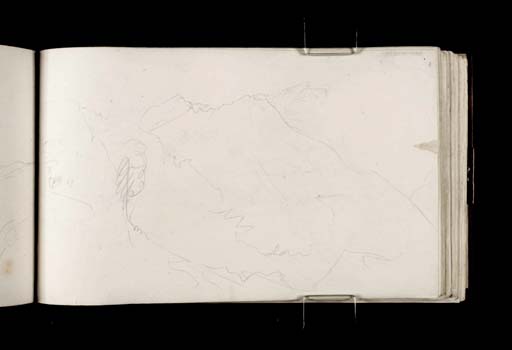Joseph Mallord William Turner The Summit of Vesuvius from Its Slopes 1819
Image 1 of 2
Joseph Mallord William Turner,
The Summit of Vesuvius from Its Slopes
1819
Joseph Mallord William Turner 1775–1851
Folio 46 Verso:
The Summit of Vesuvius from Its Slopes 1819
D15645
Turner Bequest CLXXXIV 44 a
Turner Bequest CLXXXIV 44 a
Pencil on white wove paper, 122 x 197 mm
Inscribed by the artist in pencil ‘Lava’ bottom centre right
Accepted by the nation as part of the Turner Bequest 1856
References
1909
A.J. Finberg, A Complete Inventory of the Drawings of the Turner Bequest, London 1909, vol.I, p.544, as ‘Crest of mountains’.
1984
Cecilia Powell, ‘Turner on Classic Ground: His Visits to Central and Southern Italy and Related Paintings and Drawings’, unpublished Ph.D thesis, Courtauld Institute of Art, University of London 1984, pp.180 note 42, 183 note 54, 424, as ‘Near the top of Vesuvius’.
1987
Cecilia Powell, Turner in the South: Rome, Naples, Florence, New Haven and London 1987, p.79 note 35.
An important part of the Neapolitan tourist experience was an expedition to climb Vesuvius, considered by many to be one of the greatest sights in Italy. From the seventeenth to the mid-twentieth centuries the volcano was highly active, making the journey to the top a difficult and dangerous undertaking. Nevertheless, many tourists made the hot and arduous ascent.1 According to Mariano Vasi in his guidebook, A New Picture of Naples, and its Environs (published 1820), most visitors approached the summit via the village of Resina (present-day Ercolano or Herculaneum where it was possible to hire horses and guides. From here:
it is customary only to ascend about a third part of the mountain on horseback; the guides, who are generally strong and active, then present to the travellers girdles, which are attached to their own backs, and which the latter fasten round them, and in this way proceed towards the summit. The higher they ascend the more difficult the road becomes; and as the mountain is covered with ashes, and with a sort of corrosive gravel which is very slippery, travellers would be in imminent danger of falling, were they not to take the necessary precaution of thus fastening themselves to the girdles of their conductors.2
Once at the top, tourists could walk along a narrow path around the perimeter of the crater, and, if the volcano was tranquil enough, even descend some way into its depths where the effects of the heat were reported to be equal ‘to that of a stove’.3 They could also admire the spectacular panoramic prospect across the Gulf of Naples, as recorded by John ‘Warwick’ Smith (1749–1831) in his watercolour, City of Naples from Vesuvius 1778–9 (Tate, T08509).
Turner’s sketches of the view from Vesuvius suggest that he too set out from Resina and walked up the western side of the volcano, see folios 42 verso–48 (D15637–D15648; Turner Bequest CLXXXIV 40c–46). He is known to have made the ascent in company with two other people, one of whom was Thomas Leverton Donaldson (1795–1885), a young architect from the Royal Academy.4 Donaldson later recounted that during the expedition Turner had ‘made a coloured sketch of the sky, which he did not show to his companions’.5 As Powell has discussed, no such study has been identified and it seems highly unlikely that Turner would have been able to paint in watercolour during the difficult, tiring and blistering climb.6 A more reasonable explanation is that Donaldson merely observed his companion making the pencil jottings evident in the Gandolfo to Naples sketchbook.
Although Vesuvius was particularly volatile during the years 1817–19, Turner appears not to have witnessed any spectacular first-hand volcanic activity. His visit to Naples took place during the last two weeks of October 1819 and he just missed seeing an eruption which started on 25 November, three weeks after he had returned to Rome. He would therefore never experience at first-hand the type of pyrotechnic spectacle which he had painted from his imagination in two earlier watercolours, Eruption of Vesuvius 1817 (Yale Center for British Art) and Bay of Naples (Vesuvius Angry) circa 1817 (Williamson Art Gallery, Birkenhead).7 Instead he saw the volcano much as he had depicted it in a third picture, Bay of Naples (Vesuvius in Repose) circa 1817 (private collection),8 where the only sign of life is an innocuous looking smoke trail emanating from the top. This is how the mountain appears in this on-the-spot sketch taken from a point on the slopes beneath the summit. Smoke issues from the crater and the artist has annotated his drawing with the word ‘lava’. It was perhaps as a memento of his excursion to the summit that Turner acquired a round snuff-box made from Vesuvian lava which he later gave to his friend, James Holworthy.9
Nicola Moorby
May 2010
For eighteenth-century accounts of Vesuvius see Jeremy Black, Italy and the Grand Tour, New Haven and London 2003, pp.54–5.
The name of the other person is not known. See Powell 1987, pp.80–1. Donaldson’s Roman address can be found inscribed in the back of one of Turner’s sketchbooks, see the Vatican Fragments sketchbook (Tate D15250; Turner Bequest CLXXX 81a).
How to cite
Nicola Moorby, ‘The Summit of Vesuvius from Its Slopes 1819 by Joseph Mallord William Turner’, catalogue entry, May 2010, in David Blayney Brown (ed.), J.M.W. Turner: Sketchbooks, Drawings and Watercolours, Tate Research Publication, December 2012, https://www


